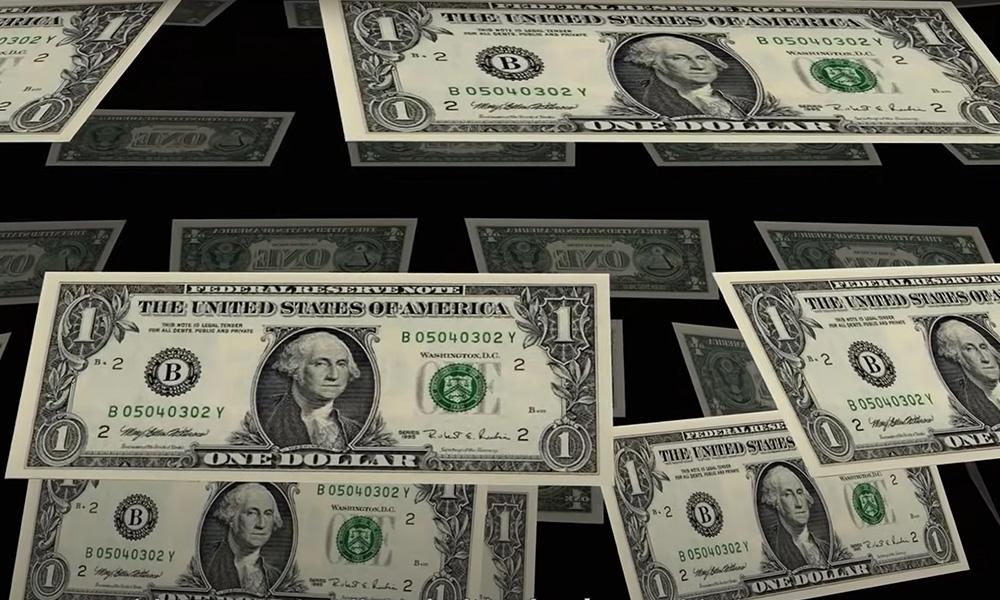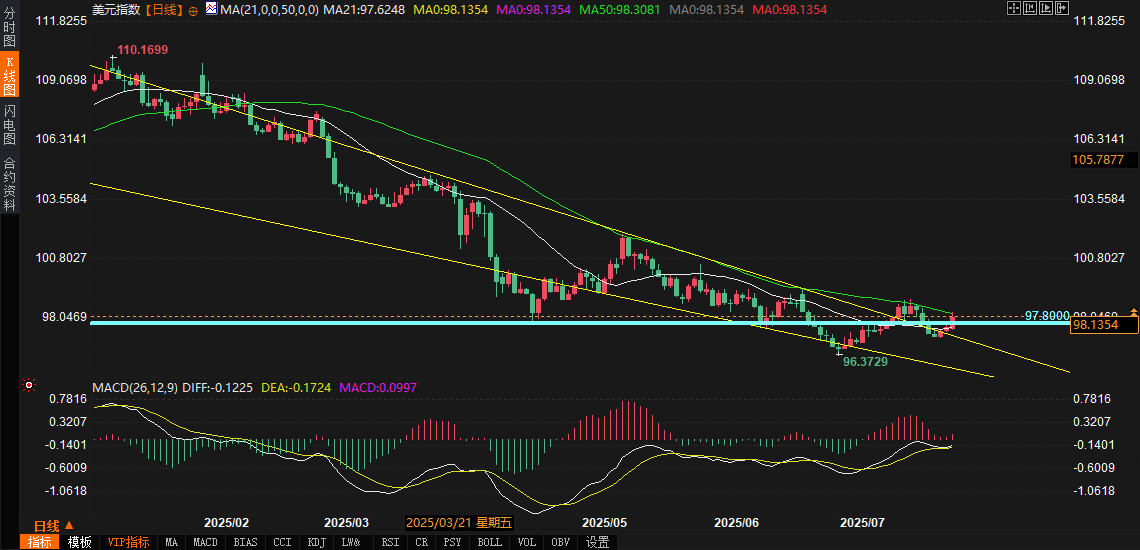The US dollar index hit the 50-day moving average at night, and staged a "beach landing" before the Fed's decision
2025-07-28 21:11:07

Fundamental analysis: Trade optimism boosts the market, and the Fed's decision attracts much attention
Last weekend, the United States and the European Union reached a breakthrough trade agreement at Trump's private golf course in Scotland, significantly alleviating market concerns about the escalation of transatlantic trade frictions. It is reported that the agreement sets the US tariff rate on major EU imports such as automobiles, semiconductors and medicines at 15%, far lower than the market's previous expectation of 30%. At the same time, the agreement includes "zero-to-zero" tariff exemptions, covering areas such as aircraft and parts, certain chemicals, semiconductor manufacturing equipment, generic drugs, agricultural products and key raw materials. In return, the EU promised to purchase US$250 billion worth of US liquefied natural gas (LNG) each year, a total of US$750 billion in three years, and plans to invest US$600 billion in the United States, focusing on strategic areas such as clean energy, defense equipment and manufacturing. Although the existing steel and aluminum tariffs remain at a high level of 50%, officials from both sides hinted that they may be gradually replaced through a quota system in the future.
The agreement was called "the biggest deal ever" by US President Trump, and his optimistic statement further consolidated market confidence, pushing S&P 500 futures up 0.4%, continuing the momentum of setting five consecutive record highs last week. European stock futures also rose 1%, reflecting the market's positive response to the easing of trade tensions. However, there are differences in the evaluation of the agreement within Europe. German Chancellor Friedrich Merz said the agreement "preserved our core interests", but the leaders of France and Hungary criticized it for being too biased towards the United States. A sharp comment by a Belgian official that "Trump completely defeated von der Leyen at the negotiating table" sparked heated discussions within the European market. Despite this, European Commission President Ursula von der Leyen emphasized that the agreement brought "stability and predictability" to "uncertain times" and demonstrated pragmatic diplomatic results.
However, the market optimism is not without concerns. Well-known economists have questioned the long-term impact of the agreement. An American economist pointed out that the 15% tariff will still push up costs for American consumers and manufacturers, especially the 50% tariff on key raw materials such as steel and aluminum, which may put pressure on the manufacturing industry. Another University of Michigan scholar further warned that even if the tariff rate seems mild, consumers will ultimately bear most of the costs, and the actual economic benefits of the agreement may be overestimated. In addition, the agreement needs to be approved by EU member states and the European Parliament, and the uncertainty of the legislative process adds variables to the market.
Meanwhile, market attention is turning to this week's intensive economic data and the Fed's decision. Tuesday's U.S. Consumer Confidence Index and JOLTS Job Openings Report will provide the market with initial clues to economic momentum. Wednesday's ADP employment data, second quarter GDP and the Fed's interest rate decision will be the highlight. Thursday's PCE inflation data and initial jobless claims, as well as Friday's non-farm payrolls (NFP), average hourly wages and ISM manufacturing PMI, will further set the tone for the dollar. The Fed is expected to keep interest rates unchanged this week, but the market will pay close attention to its wording on inflation and the economic outlook, especially in the context of recent trade optimism and tariff rhetoric.
In addition, high-level US-China trade talks will resume in Stockholm this week, with US Treasury Secretary Scott Bessant meeting with Chinese Vice Premier He Lifeng to seek an extension of the tariff truce before it expires on August 12. US Commerce Secretary Howard Lutnick stressed that there is "no room for extension" of the August 1 tariff deadline, highlighting the urgency of the negotiations. Some traders are cautious about the prospects of the negotiations, believing that it will be difficult to achieve a substantial breakthrough in the short term, and the US dollar may continue to be indirectly supported by risk aversion.
Technical analysis: DXY rebound momentum strengthens, 50-day moving average becomes key resistance
From a technical perspective, the recent trend of the US dollar index (DXY) has shown strong rebound momentum. DXY previously broke through the descending wedge pattern at the beginning of this month, establishing a bullish structure, but then failed to continue the upward trend after hitting the psychological level of 99.00, and once fell back to a two-week low near 97.00. However, buying decisively intervened in the wedge resistance-turned-support area (97.80-98.00), holding the key support, so that the effectiveness of the breakthrough was temporarily maintained. As of Monday, DXY was at 98.20, standing firm on the 21-day exponential moving average (EMA, 97.6276), and approaching the resistance level of the 50-day EMA (98.3090).
Technical indicators further support the strengthening of the rebound momentum. On the daily chart, the relative strength index (RSI) rose to 53, indicating that bullish momentum is recovering. The MACD indicator maintains a bullish pattern, although the fast and slow lines are still below the zero line, suggesting that the rebound is still in the early stages. The histogram has turned positive, reflecting the improvement in momentum after last week's pullback. If DXY can effectively break through the 50-day EMA (98.3090), it will open up space for retesting the psychological level of 99.00. On the other hand, if the support of 97.80 cannot be maintained, it may trigger a further correction, targeting 97.50 or even 97.00.
It is worth noting that the positive deviation between the current price of DXY and the 21-day EMA indicates that short-term overbought risks are accumulating, but the overall trend is still bullish. Many technical analysts pointed out that the rebound of DXY may be driven by the intensive release of data this week, especially non-farm employment and PCE inflation data, which may further push up the US dollar if they exceed expectations.

Outlook for future trends: Driven by both data and policies, the trend of the US dollar remains uncertain
Looking ahead to the next week, the trend of the US dollar index will be further clarified by the interweaving of fundamentals and technical aspects. Fundamentally, the Fed's interest rate decision on Wednesday and its statement on the economic outlook will be the focus of the market. Although the market generally expects interest rates to remain unchanged, the Fed's words on inflation and growth will directly affect the attractiveness of the US dollar. In addition, the intensive release of economic data this week, especially PCE inflation and non-farm payrolls data, will provide the market with the latest clues on the health of the US economy. If the data is strong, it may further consolidate the rebound momentum of the US dollar; conversely, if the data is weak, the US dollar may face correction pressure.
Uncertainty at the trade level remains a key variable. Although the US-EU trade agreement has boosted market sentiment, the progress of US-China trade negotiations and the approaching tariff deadline on August 1 may reignite risk aversion and indirectly support the US dollar. In addition, some institutional analysts believe that market volatility caused by tariff rhetoric may increase the safe-haven demand for the US dollar in the short term, but the long-term impact still depends on the outcome of the negotiations and the pace of global economic recovery.
Technically, the short-term trend of DXY depends on whether it can break through the 50-day EMA (98.3090). If it breaks through successfully, the 99.00 mark will become the next target, further confirming the bullish trend; if it is blocked and falls back, the support strength of the 97.80-98.00 area will determine the depth of the correction. Overall, the US dollar is expected to continue to rebound in the short term, but we need to be wary of the volatility risks brought by data and policies.
In short, the US dollar index is at a critical juncture against the backdrop of trade optimism and policy uncertainty. Investors need to pay close attention to this week's economic data and the Fed's dynamics to grasp the next direction of the market trend.
- Risk Warning and Disclaimer
- The market involves risk, and trading may not be suitable for all investors. This article is for reference only and does not constitute personal investment advice, nor does it take into account certain users’ specific investment objectives, financial situation, or other needs. Any investment decisions made based on this information are at your own risk.





















